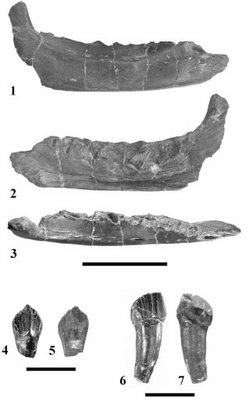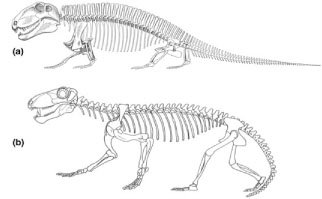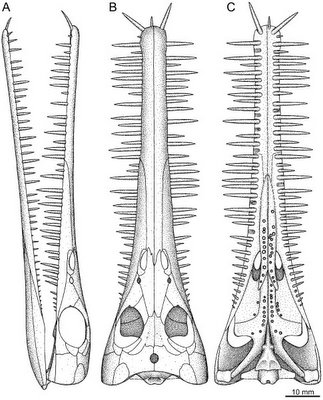 Juvenile ornithopod (Dinosauria: Rhabdodontidae) remains from the Upper Cretaceous (Lower Campanian, Gosau Group) of Muthmannsdorf (Lower Austria) Geobios, In Press, Available online 6 March 2006 Sven Sachs and Jahn J. Hornung
Juvenile ornithopod (Dinosauria: Rhabdodontidae) remains from the Upper Cretaceous (Lower Campanian, Gosau Group) of Muthmannsdorf (Lower Austria) Geobios, In Press, Available online 6 March 2006 Sven Sachs and Jahn J. HornungThe fragmentary remains of a juvenile rhabdodontid ornithopod from the Coal-bearing Complex of the Gosau Group (Lower Campanian, Grünbach syncline) at Muthmannsdorf near Wiener Neustadt, Lower Austria are revised. The material, probably belonging to a single
individual, includes a right dentary (lectotype of Iguanodon suessi Bunzel, 1871, designated herein), teeth, a fragmentary parietal, fragments of scapula, ?radius, femur, tibia, two vertebrae (lost) and a manual ungual.
The lectotype dentary does not provide clear autapomorphies or sufficient diagnostic features to determine its position within the Rhabdodontidae at generic level. By this "Iguanodon suessi" Bunzel, 1871 and the genus "Mochlodon" Seeley, 1881, to which it was latter referred as type species, cannot be characterized sufficiently by differential diagnosis and these are best considered nomina dubia.
Based upon combined character comparisons (mainly postcranial features) the Muthmannsdorf ornithopod is referred herein to Zalmoxes Weishampel, Jianu, Csiki and Norman, 2003, a genus so far known from the late Maastrichtian of Romania. It probably but not evidently represents a yet unnamed species, most closely related to Zalmoxes shpiperorum Weishampel, Jianu, Csiki and Norman, 2003. At the present state of knowledge the Austrian material is not further diagnostic at the species level and kept in open nomenclature as Zalmoxes sp.
 Un equipo de paleontólogos estadounidenses descubrió en China al dinosaurio con el cuello más extenso en promedio que el de cualquier otro animal que pobló la Tierra hace millones de años.
Un equipo de paleontólogos estadounidenses descubrió en China al dinosaurio con el cuello más extenso en promedio que el de cualquier otro animal que pobló la Tierra hace millones de años.

















